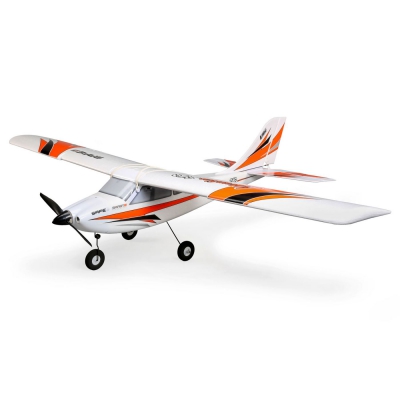E-flite Apprentice STS 1.5m BNF Basic SMT Trainer/SAFE
| FEATURES |
Construction: EPO foam
Wing: Two-piece with joiner
Brushless Motor: 840kV outrunner
Electronic Speed Control: Smart 30A brushless provides telemetry
data to compatible Spektrum AirWare equipped transmitters such as
the DX6e & 8e, DX6 & 8, DX6 & 8 G2, DX9, iX12 and others
Radio: Spektrum DXe DSMX
trainer port, w/Spektrum 4650 Serial receiver
Receiver: Spektrum DSMX SRXL2 with SAFE (Sensor Assisted Flight
Envelope), Beginner, Intermediate and Experienced flight modes, and
Panic Recovery that pulls aircraft out of a dive, rolls wings
upright and recovers aircraft to a safer attitude
Flight Controller: Spektrum 3230
Servos: Four standard, two micro
Landing Gear: Prebent wire, tricycle configuration with steerable
nose wheel, three 2.5" (65mm) diameter wheels, optional floats
available separately
LiPo Battery: Smart 3S 11.1V 3200mAh w/IC3 connector
Battery Charger: Spektrum S120 USB-C Smart Charger
| INCLUDES |
E-flite BNF Basic Apprentice STS Smart Trainer with DSMX Receiver
w/SAFE, Receiver, ESC, Flight Controller, Brushless Motor,
Propeller and Instruction Manual
| REQUIREMENTS |
Transmitter: 2.4GHz full range, at least 6-channel, Spektrum DSMX/
DSM2 compatible
LiPo Battery: 3200mAh 3S 11.1V 30C with IC3 or EC3 connector
Battery Charger and Charge Bag: Compatible with selected battery
| SPECIFICATIONS |
Wingspan: 59" (1500mm)
Length: 42.5" (1080mm)
Wing Area: 515 sq in (33.2 sq dm)
Flying Weight: 49oz (1390g)
Airfoil: Flat bottom
Configuration: High wing
Approximate Assembly Time: Less than one hour
Approximate Flight Time: 5 minutes
Center of Gravity (CG): 3.125" (79mm) from leading edge of wing
measured at the fuselage
Control Throws: Low Rate High Rate
Elevator, up/down: 0.71" (18mm) 0.91" (23mm)
Aileron, up/down: 0.71" (18mm) 0.91" (23mm)
Rudder, left/right 1.10" (28mm) 1.35" (35mm)
| COMMENTS |
The Apprentice is compatible with the all-new Spektrum Landing
Assist Sensor (LAS). It is easy to install and provides automatic
flare control to help inexpreienced pilots "grease" landings by
minimizing or completely eliminating bouncing. LAS works over
most surfaces and provides optimum performance when flying over,
or landing in grass.

